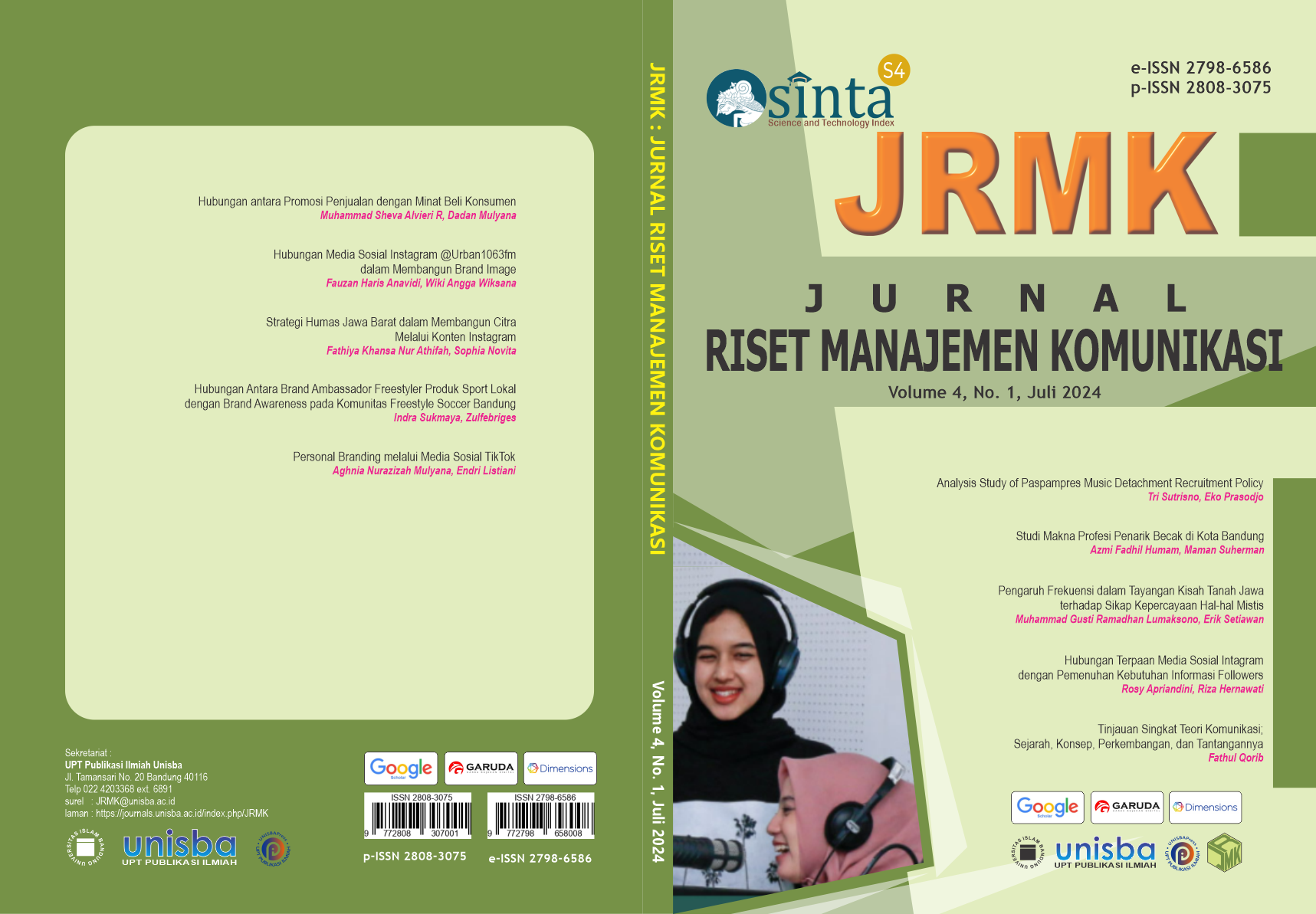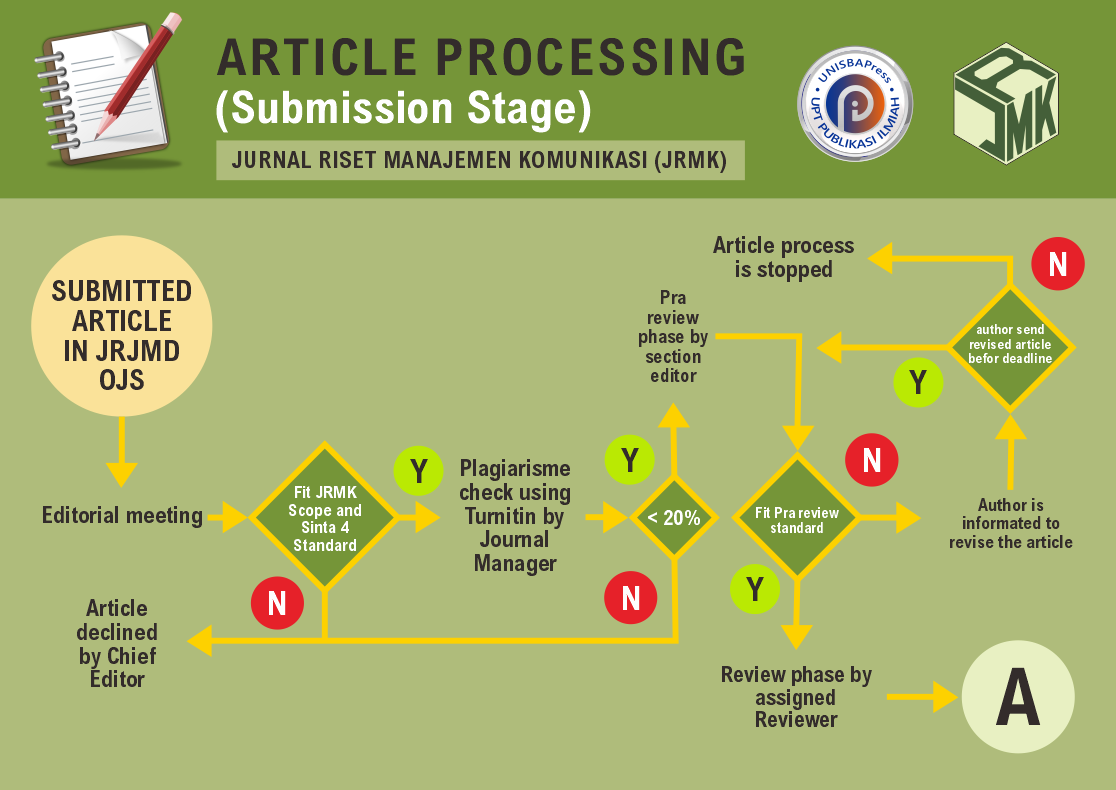Tinjauan Singkat Teori Komunikasi; Sejarah, Konsep, Perkembangan, dan Tantangannya
DOI:
https://doi.org/10.29313/jrmk.v4i1.4014Keywords:
Komunikasi Kontemporer, Sejarah Komunikasi, Teori KomunikasiAbstract
Abstract. This article is a concise attempt to understand communication theory by exploring its historical origins, conceptual foundations, development trajectory, and challenges of the contemporary era. This article's introduction provides an overview of communication and highlights the role of communication theory in understanding the complexity of human interaction. This research uses a comprehensive literature review to trace the history of the development of communication theory and identify key concepts in the field of communication. In the discussion section, this article explores important theoretical concepts in communication theory, from initial linear models to more complex interactive and transactional models. This research also explains the interdisciplinary nature of communication theory, highlighting how communication theory integrates various fields of study. In modern times, this article describes critical traditions, cultural communication, digital media, the emergence of new media platforms and theoretical gaps that need more attention. The conclusion of this article aims to collect the results, highlight the relevance of communication theory, and suggest directions for improvement and innovation. This article will contribute to a deeper understanding of the historical context of communication theory, new conceptual perspectives, developmental dynamics, and challenges faced today in a changing media landscape.
Abstrak. Artikel ini merupakan upaya ringkas untuk memahami teori komunikasi dengan mengeksplorasi asal-usul sejarah, landasan konseptual, lintasan perkembangan, dan tantangan era kontemporer. Pengantar artikel ini memberikan gambaran umum tentang komunikasi dan menyoroti peran teori komunikasi dalam memahami kompleksitas interaksi manusia. Penelitian ini menggunakan tinjauan literatur yang komprehensif untuk menelusuri sejarah perkembangan teori komunikasi dan mengidentifikasi konsep-konsep kunci dalam bidang komunikasi. Pada bagian pembahasan, artikel ini mengeksplorasi konsep-konsep teoretis penting dalam teori komunikasi, mulai dari model linier awal hingga model interaktif dan transaksional yang lebih kompleks. Penelitian ini juga menjelaskan sifat interdisipliner teori komunikasi, menyoroti bagaimana teori komunikasi mengintegrasikan berbagai bidang studi. Di zaman modern, artikel ini memaparkan tradisi kritis, komunikasi budaya, media digital, munculnya platform media baru dan kesenjangan teoritis yang perlu mendapat perhatian lebih. Kesimpulan artikel ini bertujuan untuk mengumpulkan hasil, menyoroti relevansi teori komunikasi, dan menyarankan arah perbaikan dan inovasi. Artikel ini akan berkontribusi pada pemahaman yang lebih mendalam tentang konteks historis teori komunikasi, perspektif konseptual baru, dinamika perkembangan, dan tantangan yang dihadapi saat ini dalam lanskap media yang terus berubah.
References
Andersen, P. H. (2001). Relationship development and marketing communication: An integrative model. Journal of Business and Industrial Marketing, 16(3), 167–182. https://doi.org/10.1108/08858620110389786/FULL/XML
Baltzersen, R. K. (2013). The Importance of Metacommunication in Supervision Processes in Higher Education. International Journal of Higher Education, 2(2). https://doi.org/10.5430/ijhe.v2n2p128
Baudrillard, J. (1998). TheConsumer Society: Myths and Structures. SAGE Publications.
Benson, R. (2009). Shaping the Public Sphere: Habermas and Beyond. The American Sociologist, 40(3), 175–197. https://doi.org/10.1007/s12108-009-9071-4
Bradbury, H., Roth, G., & Gearty, M. (2015). The Practice of Learning History: Local and Open System Approaches. In The SAGE Handbook of Action Research: Participative Inquiry and Practice (3rd Edition). SAGE.
Briant, P. (2017). On “Achaemenid impact” in Anatolia. In A. P. Dahlén (Ed.), Achaemenid Anatolia: Persian Presence and Impact in the Western Satrapies 546–330 BC. Uppsala University Library.
Butler, J. (2020). Performative Acts and Gender Constitution : An Essay in Phenomenology and Feminist Theory. In Feminist Theory Reader (5th Edition). Routledge. https://doi.org/10.4324/9781003001201-42
Castells, M. (2007). Communication, Power and Counter-power in the Network Society 1. In International Journal of Communication (Vol. 1). http://ijoc.org.
Castells, M. (2010). Communication Power: Mass Communication, Mass self-Communication, and Power Relationships in the Network Society. In J. Curran & D. Hesmondhalgh (Eds.), Media and Society (6th Edition). Bloomsbury Publishing.
Chron, C. (2021). The Relationship Between Marketing & Communication. Smallbusiness.Chron.Com. https://smallbusiness.chron.com/relationship-between-marketing-communication-64784.html
Cobley, P. (2008). Communication : Definitions and Concepts. In The International Encyclopedia of Communication (Issue 1983, pp. 660–666). John Wiley & Sons, Ltd. https://doi.org/10.1002/9781405186407
Colburn, H. P. (2013). Connectivity and communication in the achaemenid empire 1. Journal of the Economic and Social History of the Orient, 56(1), 29–52. https://doi.org/10.1163/15685209-12341278
Craig, R. T. (2006). Communication as a Practice. In C. Blair, G. J. Shepherd, J. S. John, & T. Striphas (Eds.), Communication as …: Perspectives on Theory Communication as Collective Memory (p. 276). SAGE Publication, Inc.
Deuze, M. (2007). Convergence culture in the creative industries. International Journal of Cultural Studies, 10(2), 243–263. https://doi.org/10.1177/1367877907076793
Foss, S. k., & Griffin, C. l. (1995). Beyond persuasion: A proposal for an invitational rhetoric. Communication Monographs, 62(1), 2–18. https://doi.org/10.1080/03637759509376345
Foucault, M. (2020). Power/Knowledge. In The New Social Theory Reader. Routledge. https://doi.org/10.4324/9781003060963-10
Gaines, R. N. (1984). Special reports: Studies in Cicero’s opera rhetorica. Central States Speech Journa4, 35(2), 120–123. https://doi.org/10.1080/10510978409368172
Gerbner, G. (1998). Cultivation Analysis: An Overview. Mass Communication & Society, 3(4), 175–194.
Giddens, A. (2009). Sociology (6th Edition). Wiley India Pvt. Ltd.
Gillis, T. L. (2006). The IABC Handbook of Organizational Communication. Jossey Bass.
Gromova, K. (2017). Plenty of Fish in the Academy: On Marshall McLuhan’s Prose as an Anti-Environment. Philosophies, 2(4), 7. https://doi.org/10.3390/philosophies2020007
Guddemi, P. (2020). Bateson, Cybernetics, and Nonverbal Communication. In Gregory Bateson on Relational Communication: From Octopuses to Nations (20th ed., pp. 1–7). Springer. https://doi.org/10.1007/978-3-030-52101-1_1
Habermas, J. (1991). The Structural Transformation of the Public Sphere: An Inquiry into a Category of Bourgeois Society (T. by T. Burger, Ed.). The MIT Press.
Hadi, I. P. (2007). Cultivation Theory Sebuah Perspektif Teoritik dalam Analisis Televisi. In Jurnal Ilmiah SCRIPTURA (Vol. 1, Issue 1).
Hall, S. (2010). Encoding - Decoding. In Crime and Media: A Reader. Taylor and Francis. https://doi.org/10.4324/9780367809195-6/ENCODING
Hemels, J. (2018). Recognition and Development of Communication Science in the Netherlands. Revista FAMECOS, 25(2), 30161. https://doi.org/10.15448/1980-3729.2018.2.30161
Jain, N., & Mukherji, S. (2009). Communicating a holistic perspective to the world: Kautilya on leadership. Leadership and Organization Development Journal, 30(5), 435–454. https://doi.org/10.1108/01437730910968705
Katz, E. (1957). The Two-Step Flow of Communication: An Up-To-Date Report on an Hypothesis. Public Opinion Quarterly, 21(1), 61–78.
Kim, M.-S. (2002). Non-Western Perspectives on Human Communication: Implications for Theory and Implications for Theory and Practice. SAGE Publications, Inc.
Kuhn, T. S. (Thomas S. (1962). The Structure of Scientific Revolutions.
Leff, M. (1998). Cicero’s “Pro Murena” and the Strong Case for Rhetoric. Rhetoric and Public Affairs, 1(1), 61–68. http://www.jstor.org/stable/41939431
Lewin, M. (1992). The Impact of Kurt Lewin’s Life on the Place of Social Issues in His Work. Journal of Social Issues, 48(2), 15–29. https://doi.org/10.1111/j.1540-4560.1992.tb00880.x
Lewis, N. A., & Wai, J. (2021). Communicating What We Know and What Isn’t So: Science Communication in Psychology. 16(6), 1242–1254. https://doi.org/10.1177/1745691620964062
Littlejohn, S. W., & Foss, K. A. (2014). Teori Komunikasi : Theories of Human Communication (T. oleh M. Y. Hamdan, Ed.). Salemba Humanika.
Luhmann, N. (1992). What is Communication? Communication Theory, 2(3), 251–259. https://doi.org/10.1111/J.1468-2885.1992.TB00042.X
McLuhan, M. (1964). Understanding Media: The Extensions of Man. McGraw-Hill.
Miller, G. A. (1951). Language and Communication. McGrow Hill Company.
Mitroff, I. I., & Mitroff, D. D. (1979). Interpersonal Communication for Knowledge Utilization. Knowledge, 1(2), 203–217. https://doi.org/10.1177/107554707900100203
Neiman, T. S. (2011). Communication in Conflict and Problem-solving: A Study of Dialogue in Everyday Life [Dissertation]. Simon Fraser University.
Neuman, W. L. (2014). Social Research Methods: Qualitative and Quantitative Approaches (Seventh Edition). Pearson Education Limited.
Nurlela, N., & Anggraini, I. (2022). Peran Komunikasi Pemasaran dalam UMKM : Pembelajaran untuk Pemberdayaan UMKM Kelompok Wanita Tani di Pedesaan. MENARA RIAU, 16(2), 79–88. https://doi.org/10.24014/MENARA.V16I2.19427
Pooley, J. (2017). Wilbur Schramm and the “Four Founders”: History Of U.S. Communication Research. Коммуникации. Медиа. Дизайн, 2(4).
Purwanto, B. (2018). THEORI KULTIVASI : KEGADUHAN POLITIK DAN PERILAKU MASYARAKAT. IKRAITH-Humaniora, 2(2). http://www.aktual.com/pengusaha-ngeluh-
Rogers, E. M. (1997). History Of Communication Study: A Biographical Approach. Free Press.
Ruiz-Moral, R., & Ghebrehiwet, T. (2023). Communication and Relationships in Person Centered Medicine. Person Centered Medicine, 123–133. https://doi.org/10.1007/978-3-031-17650-0_7
Said, E. (2004). Introduction to Orientalism. In Imperialism (1st Edition). Routledge. https://doi.org/10.4324/9781003101536-3
Scholl, W. (2013). The socio-emotional basis of human interaction and communication: How we construct our social world. Social Science Information, 52(1), 3–33. https://doi.org/10.1177/0539018412466607
Schramm, W. (1995). The Process Effect Of Mass Communication,. University Of Illinois Press Urbana.
Shannon, J., Quimby, C., Colwell, C., & Burg, S. (2021). Anthropology, Empathy, and the Need for Social Science Communication. 43(4), 529–537. https://doi.org/10.1177/10755470211018812
Sharkiya, S. H. (2023). Quality communication can improve patient-centred health outcomes among older patients: a rapid review. BMC Health Services Research, 23(1), 1–14. https://doi.org/10.1186/S12913-023-09869-8/TABLES/6
Snell, R. S., Wu, C. X., & Lei, H. W. (2022). Junzi virtues: a Confucian foundation for harmony within organizations. Asian Journal of Business Ethics, 11(1), 183. https://doi.org/10.1007/S13520-022-00146-1
Sondhi, S. (2020). Sabdanusanam: The Integral View of Communication. Kalakalpa IGNCA Journal for Arts, 4(2), 1–16.
Spender, D. (1985). Man Made Language. Routledge.
Stowell, J. A. (2003). The Influence of Confucian Values on Interpersonal Communication in South Korea, as Compared to China and Japan. Intercultural Communication Studies, 7(4), 233–245
Teixeira, L. A. G. (2014). Rhetoric for philosophers: An examination of the place of rhetoric philosophy. ProQuest LLC.
The brain chamber. (2023). The Behistun Inscription | The Brain Chamber. Thebrainchamber.Com. https://thebrainchamber.com/the-behistun-inscription/
Turkel, G. (1990). Michel Foucault: Law, Power, and Knowledge. Journal of Law and Society, 17(2), 170-189. https://doi.org/10.2307/1410084
Turkle, S. (1997). Life on the Screen: Identity in the Age of the Internet. Simon & Schuster.
Widyawati, A. A., Ambarnuari, M., Agung, A., Bagus, G., & Denpasar, S. (2021). Yoga Sebagai Sarana Menuju Tuhan Yang Advaita. Jurnal Yoga Dan Kesehatan, 4(1). http://ejournal.ihdn.ac.id/index.php/jyk
Wood, J. T. (2004). Communication Theories in Action: An Introduction. Wadsworth.














